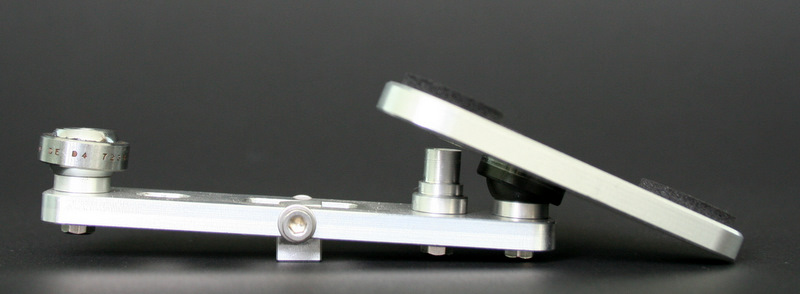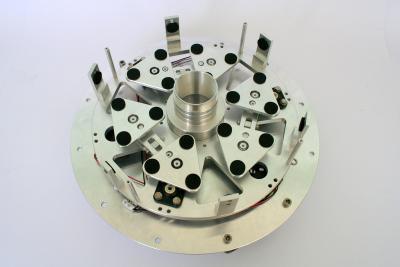NortheK presents one of the leading models of the 250 mm series: the Classic Cassegrain 250 mm f/15.
This optical design, consisting of a parabolic primary mirror and a hyperbolic secondary mirror, is not easily found in the amateur market due to the complexity of producing the optical figures, in favour of layouts suitable for producing large quantities and which optical design has reduced production costs, especially if the structural and mechanical characteristics are not dominant issues. In fact, for larger diameter and/or professional use telescopes, the classical Cassegrain configuration is commonly considered the most suitable.
Thanks to its relatively wide corrected field, as well as for high-resolution use, the instrument can also be fully exploited for taking images of objects with small angular size. In addition, when coupled to a corrector/reducer, it can be used for deep-sky observations, as indeed it is often the case with greater diameters telescopes – assuming, of course, that the mount is up to this kind of task.This added value, if compared, for example, to a Dall-Kirkham, would only be marginal as the deep-sky applications of this latter are of little significance, given that it is a specialized telescope which within its corrected field has even better spot diagrams than the Cassegrain (see Fig. 2), but that performs at its best only within a field that is too narrow to be interesting in the deep-sky and whose performance coupled to a corrector/reducer remains anyhow mediocre. The strength of the Dall-Kirkham is obviously the high-resolution and very little else. Its lower cost, the greater ease of collimation and the possibility to optimally work with optics between f/18 and f/25 (without using multipliers), assigns the Dall-Kirkham to different applications than those where a classic Cassegrain is instead more appropriate.
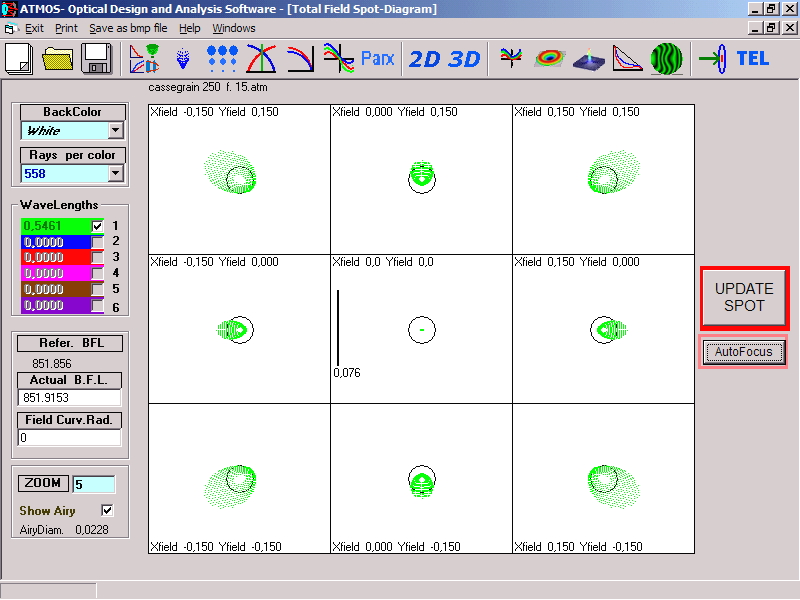
Above, an optical tracing of the NortheK Cassegrain 250 mm f/15. The black circle is the Airy disk and the green dots represent the deformation on the focal plane.
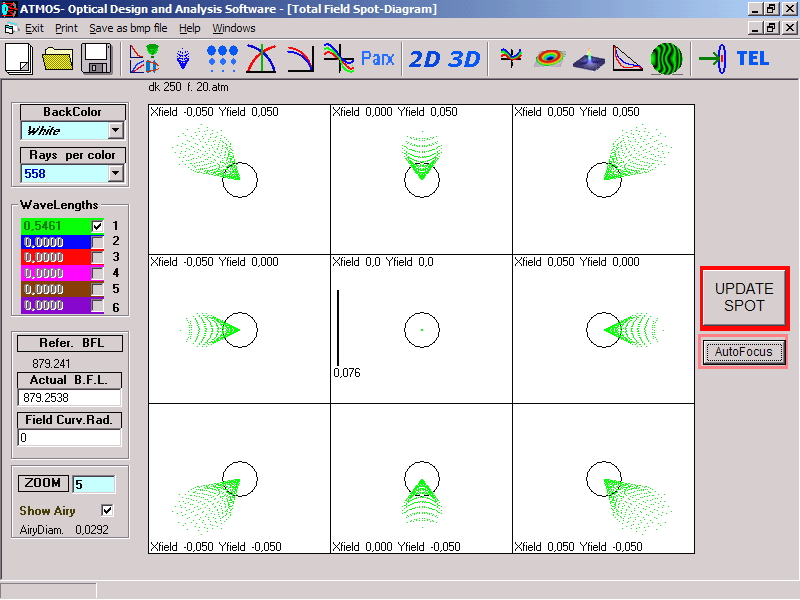 Here we can see the same tracing, but this time of the NortheK Dall-Kirkham 250 mm f/20.
Here we can see the same tracing, but this time of the NortheK Dall-Kirkham 250 mm f/20.
The instrument is constructed in carbon and aluminium alloy materials, with utmost attention to the mechanical parameters to ensure that every component work together as efficiently and smoothly as possible. Although the “rule of thumb” seems to be that many structural features are pointless, this is then usually disconfirmed when the telescope is used frequently and from the same are expected repeated results at the limit of the aperture and configuration.
The Cassegrain 250 mm f/15 is made to be used also on all those evenings when the seeing is perhaps not the best since, thanks to its design features, it can still make the observing session enjoyable and useful. Not an insignificant factor when considering the current conditions of the skies over Europe and beyond, and also the lesser free time available to amateur astronomers to get ready for a couple of hours of leisure.
Before going into the details of its construction, the following technical data sheet shows the main characteristics and specifications guaranteed by the manufacturer:
| Optical Characteristics | Technical Specifications |
| Optical design | Classic Cassegrain |
| Nominal optical aperture | 254 mm |
| Effective optical aperture | 250 mm |
| Focal ratio | f /15 |
| Primary mirror focal ratio | f /3 |
| Focal length | 3800 mm |
| Back Focus | 250 mm |
| Primary mirror thickness | 25 mm |
| Primary and secondary mirrors material | Suprax Glass Schott Germany |
| Substrate | Quartz coated aluminium (SiO2) |
| Optical surface correction | Diffraction-limited |
| Strehl ratio | 0.96 |
| Average reflectivity | 94% |
| Primary mirror aperture stepping | 4 mm |
| Secondary mirror diameter | 55 mm |
| Secondary mirror thickness | 15 mm |
| Secondary mirror magnification factor | 5x |
| Effective total obstruction | 30 % |
| Fully illuminated field diameter | 20 mm |
| Mechanical Characteristics | Technical Specifications |
| Telescope maximum diameter | 360 mm |
| Carbon fiber optical tube’s inner diameter | 280 mm |
| Optical tube overall length (without accessories) | 935 mm |
| Total telescope weight (without accessories) | 17 kg |
| Primary mirror support cell | NortheK StabilobloK |
| Secondary mirror support system | NortheK AxyS |
| Optical tube overall structure | NortheK UnitorK |
| Dovetail/plate adapter mount | Customer’s choice |
| Outer protection | Hard anodization (black-coloured) |
| Screws and bolts | Stainless steel, Ergal |
| Optics cap | Aluminium |
| Standard Equipment | Technical Specifications/Notes |
| Finderscope | 8×50 illuminated achromatic finder |
| Focuser | Feather Touch FTF 2000 2″ – without 31.8 mm reducer |
| Maintenance tool box | Included |
| Use-maintenance manual | Included |
| Optics cap | Included |
| Primary mirror baffles | On request |
| Options and accessories | |
| Thermometric probe | On request |
| Optics cleaning set | On request |
| Carbon fiber connectors for attaching accessories | On request |
| MKIT 20 Feather Touch motorized focuser | On request |
Glancing through the above sheet, it is at once possible to make some practical and technical considerations.
The primary mirror is an f/3, an optical element very difficult to produce especially when considering the small dimensions of the telescope in which it is incorporated and that consequently cannot exceed certain sales prices. This choice is due to the need to maintain the distance between the primary and secondary mirrors as low as possible, in order to have a fairly light and short optical tube, ideal for amateur mounts with a load capacity up to 25 kg. The primary mirror is made from Schott Suprax and it is only 25 mm thick (2.5 kg), which is quite revolutionary if compared to the many 45-50 mm mirrors weighing 5 kg found in quality telescopes. Why this choice? Certainly not to save on the cost of the glass. Actually, the thinner it is and the more difficult it is to precision finish its surface, besides the fact that a user who buys a telescope in this price range is supposedly well aware of the heat and thermal equilibrium problems of a high-resolution instrument. Using very simple programs downloadable from the internet, it is possible to see how quickly the telescope temperature is reached, but even more how easy it is to keep under control the temperature difference between the glass and the external environment (the thermal delta). Amateur astronomers who use this telescope say that very often there is no need to resort to the forced ventilation system and that after about 30-40 minutes everything has reached such an equilibrium that the heat plumes are no longer visible.
The secondary mirror is of a suitable size, not so much for the typical amateurs’ obsession to look for infinitesimal obstructions, but for maintaining the mechanical ratios, the distance between the primary and secondary mirrors and the back focus in perfect harmonization with each other, as otherwise it would be pointless to own an instrument with an obstruction of 20% if the same is then turned into something hardly usable by the various users because of an excessive number of connectors, recording equipment or visual observation systems. The secondary mirror has a multiplication factor of 5, which means that it multiplies by 5 the focal length of the primary mirror. A fairly high factor rarely applied by other manufacturers as this implies the highest quality and finishes of the optical surfaces as well as the use of high precision mechanical parts, all elements that may seem like an “unnecessary cost”, but that are fundamentally essential. First, they guarantee that the optical construction meets strict parameters, requiring the manufacturer to be very careful before certifying the optical tube, and second, they allow to keep the lever-arm effect and weight extremely low, to all advantage of amateur mounts.
Just as example, here is a picture taken under unfavourable seeing conditions with the Cassegrain 250 mm f/15 on a Celestron CGEM mount:

Although the amount of details in the original image is much greater, it is nonetheless possible to note that the quality is well above the average of other telescopes with the same diameter, especially when considering the unfavourable seeing. (Photo: Andrea Maniero – Padua).
The optics are made by a British manufacturer, Oldham Optical, represented in Italy by NortheK, which entrusts to the former the construction of most of its optical designs. As can be seen from the technical data sheet, the optics are diffraction-limited, thus allowing the system to work to the maximum permitted by its diameter. For lovers of figures, each individual mirror is accompanied by an optical certificate from the manufacturer, typically P-to-V 1/10, RMS 1/30, Strehl 0.96 (550 nm), and all parameters are obtained in autocollimation mode with the Double Pass Null test. For those wanting to move even further (in optical terms), the glass can be replaced with Supremax 33 from Schott (the new Pyrex) or the best-performing ever Clearceram-Z from Ohara, a virtually zero expansion ceramic glass which though costs 9 times as much as the Supremax 33. These kind of subtleties are obviously reserved to extremely demanding users who refuse to compromise.
The optics are housed in a modular cell fitted by the manufacturer to all telescopes of this diameter. The cell, marketed by NortheK under the trade name of StabilobloK 25, is made of flattened, CNC machined aluminium alloy sheets (no real telescope worth having uses non-flattened sheets, as it can be easily confirmed by visiting some of the most qualified manufacturer of also very large instruments: a plain is a plain and it should be kept as such to allow the accurate positioning of all mechanical auxiliary elements). The design has been revised several times and the model that is currently fitted is what we could call the definitive version (retrofitted to all telescopes produced): 6 supporting and centering side pads in a central anti-mirror flop system, 18 floating points mounted on steel and sintered bronze bearings, and primary mirror perimeter mask. Much attention has been placed on the subject of working with thin glass as deformations induced by the mechanical components are always round the corner and very detrimental. For this reason, it has been chosen the precision-made 18-points floating system (considered by some excessive, but that it actually eliminates any unpredicted deformation of the glass disk), assembled with utmost care and attention in view of the fact that at these levels of accuracy even the slightest variation from the calculations made on the simulator will produce suboptimal results. To this end, the swivel-joints system of each cell undergoes a factory “run-in” during which the reaction forces are measured to verify that they well within the design tolerances.
Here is an example of how the floating system is assembled before being fitted to the support plate. Each element is precision-milled to ensure that the contact and deformation points are exactly where they should be.
A significant detail is the innovative collimation system of the primary mirror. Although the norm for achieving collimation is by way of 6 or more push-pull screws, this very economical and simple method is not, however, without drawbacks. These are immediately obvious to anyone when tightening the collimation screws with magnification set at 800-1000x. If, then, these screws and relative housing are cheaply made or with a coarse thread pitch, it is near impossible to achieve results matching the quality of the installed optics. The manufacturer has therefore designed a system that uses axial displacement micrometers with internal reducer, and with 0.02 mm accuracy. To these micrometers, made ??with a steel casing, is fixed the displacement steel shaft h7 which controls a polymer ball joint that fine-tunes the position of the plate supporting the floating points. The direct end result of this design is that primary mirror’s collimation can be achieved with absolute accuracy and without using tools or wasting time, and that no deforming forces are downloaded on the plate holding the mirror (which in turn would be transferred to the glass disk itself), whilst obviously keeping the weight extremely low. The classic plate compression springs have therefore been eliminated thanks to the micrometric system; though it must be pointed out that the spring system is solely to the benefit of the manufacturer as it significantly lowers the production costs, except of course using ??specifically designed springs for which the relative compression and decompression diagram can be accurately assessed, but this is not the case for any telescope and the result is that each spring works as it wants and downloads unpredicted forces where it happens.
Interestingly, despite the psychological fear that by touching the micrometers with a hand this may cause inappropriate displacements, this cannot however happen because they are mounted on polymer thrust bearings making their rotation deliberately “forced” and regulated in such a way as to allow the safety of movement that an accuracy of 0.02 mm requires (otherwise it would not be possible to achieve it).
The manufacturer has eliminated the concept of a self-supporting central sleeve (present in many telescopes, including expensive ones), due to the fact that such a system, if built with stability and strength criteria, would practically cost as much as the 18 floating points cell and would greatly increases the telescope weight, thus losing some of the initial benefits of the design
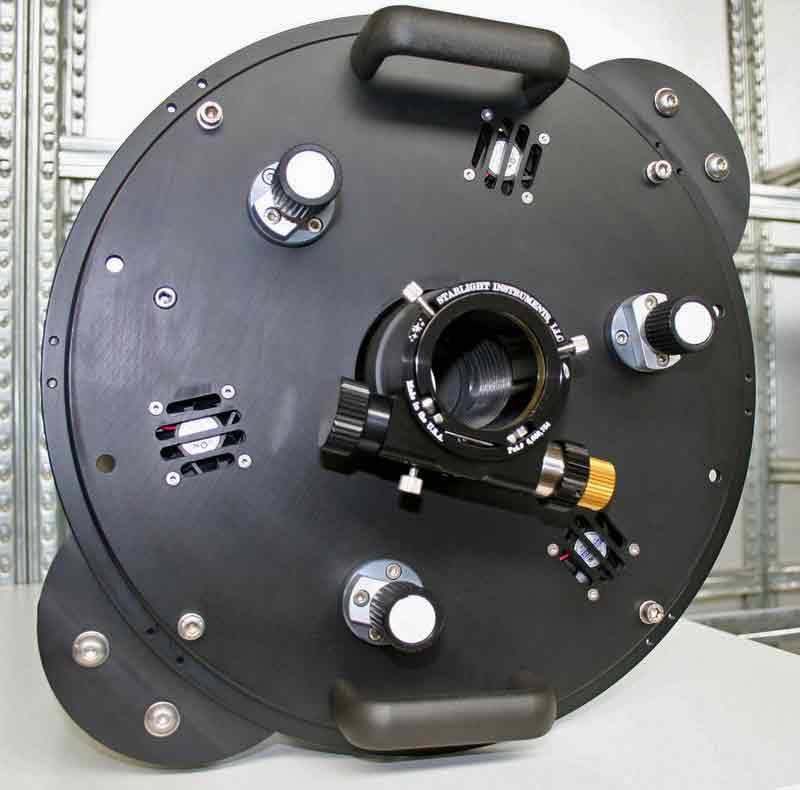
Here is the bottom of the Cassegrain 250 mm housing the focus adjustment motor, which is remotely controlled and equipped with thermal sensor. Clearly visible are also the micrometers and the forced cooling system.
Above is the assembled primary mirror’s cell, where can be noticed the large number of precision machined components necessary to allow very thin and light mirrors to work in the most suitable manner.
A key detail that is part of the continuous technical innovation, is that also the Cassegrain 250 mm f/15 is fitted with the self-centering system for the mechanical-optical system. This simple engineering concept allows to collimate the primary mirror – once this has been centred in its cell by means of the side pads – while maintaining constantly and always on-axis the primary mirror hood, the focus and the whole rear mechanical-optical train. This little innovation eliminates many off-axis (misinterpreted as discollimation), strengthens the structure and shifts the centre of gravity more towards the middle of the system, with obvious advantages for the rear optical train. So much so that the problems that will then emerge will be due to commercial couplings, out of true CCD’s nosepieces and whatever else.
In a Cassegrain telescope this is a very important factor since, as any experienced amateur astronomer can confirm, the accuracy of the collimation is the very foundation on which a design concept must be based, especially when specific amateur issues are at stake (dimensions and weight). It is well known that a focus inaccuracy of 0.01 mm will compromise the quality of the photographic image. In terms of focus, a hundredth of a millimetre means that also the optical tube, the cell, the support for the secondary mirror and the focusing system must be absolutely stable and constant. In critical optical elements such as in the Cassegrain configuration, this issue is even more fundamental. The NortheK Cassegrain 250 mm f/15 is built in accordance with these technical principles, with the purpose of supplying a technical asset and not just a basic amateur instrument.
From all the above it follows that also the secondary mirror must be fitted with a very precise and stable adjustment and collimation system. In the Cassegrain 250 mm, as in all other models, there are two elements that must be carefully evaluated:
the distance between the primary and secondary mirrors, which must be precise and optimized so as to achieve the correct back focus and not introduce undesirable optical aberrations;
the possibility to adjust the tilt of the mirror with absolute ease and without the occurrence of any play or displacement, both during adjustment and during use.
Below is the layout of the Cassegrain 250 mm. Some parameters vary as a function of the individual optical set, and are given as reference in the optical certificate. However, prior to delivery, the manufacturer sets each instrument as per attached certificate, leaving to the amateur astronomer the possibility to personally regulate, within certain parameters, such settings.
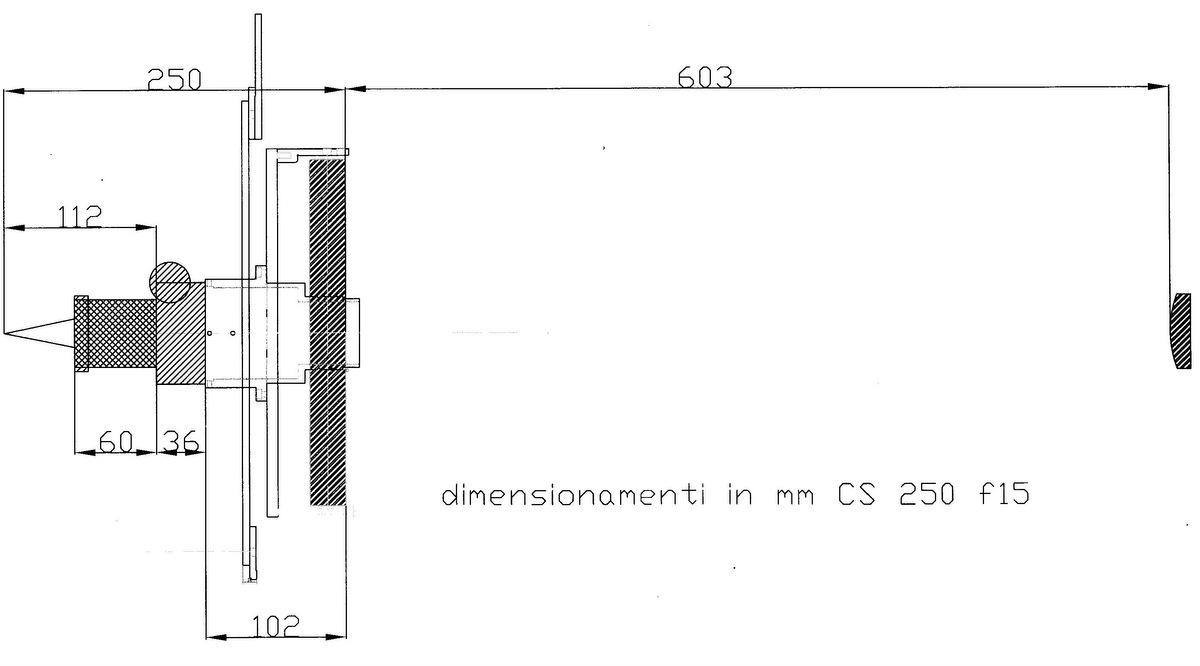
This basic drawing provides the customer the dimensions imposed by the mechanical design and typical of each optical set.
The distance parameter primary/secondary mirror determines also a lengthening or shortening of the back focus (the distance from the centre of the primary mirror surface to the focal plane), usually equal to 250 mm but that can slightly vary from instrument to instrument and that can be increased or decreased by a certain extent by the amateur astronomer. A careful star test will tell if this has been too shortened or lengthened, and AxyS helps to accomplish this task in a masterly way.
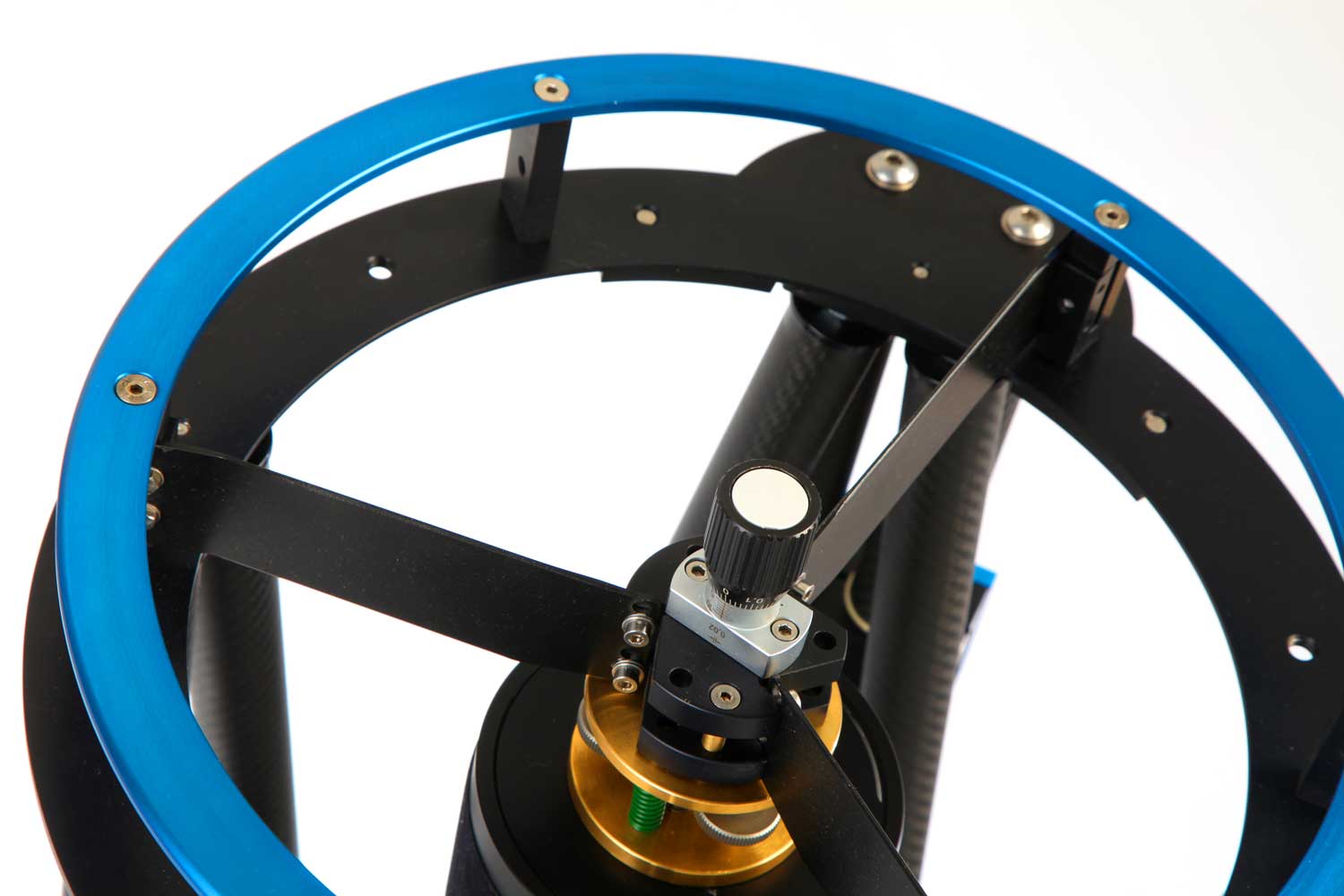
AxyS, the third element fitted as standard by the manufacturer, is a very advanced support system for secondary mirrors which, as well as an absolute stability, also ensures the best possible optimization of the optical arrangement. Worthy of note is the axial micrometer that allows to regulate with an accuracy of 0.02 mm the distance between the primary and secondary mirrors by moving back and forth the whole unit without collimating the telescope. There are then three micro-threaded screws positioned on a brass flange which permit to fine-tune the mirror’s tilt, and three controlled compression springs that allow to make adjustments without unexpected or “undesirable” jolts during observations – the whole is mounted on precision ground steel spindles and self-lubricating polymer bearings.
